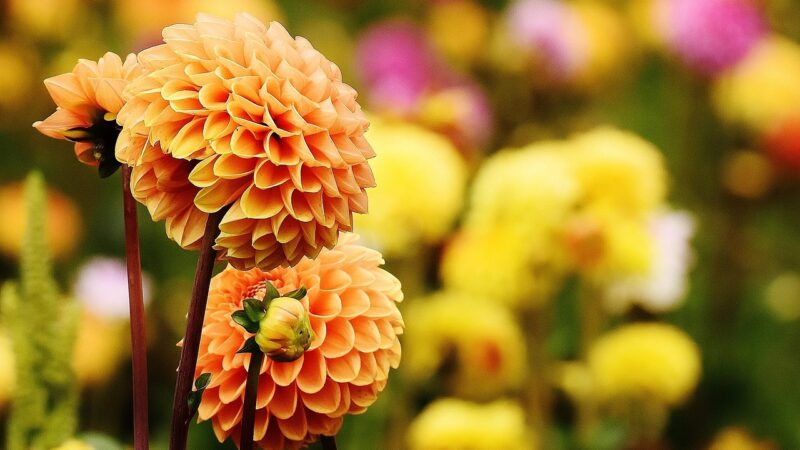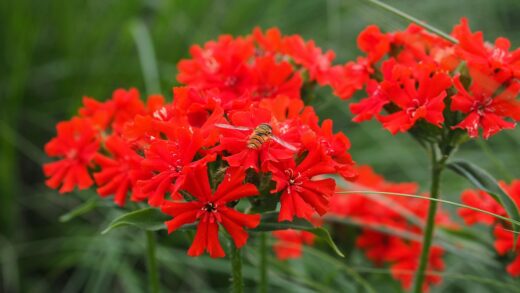The light requirements of the dahlia

Sunlight is the fundamental source of energy for dahlias, directly fueling the process of photosynthesis which is essential for their growth, health, and, most importantly, their ability to produce a profusion of stunning blooms. Understanding the specific light requirements of these sun-loving plants is not merely a suggestion but a prerequisite for successful cultivation. The quantity and quality of light a dahlia receives will dictate its overall size, the sturdiness of its stems, the intensity of its flower color, and the sheer volume of flowers it produces throughout the season. Providing the optimal amount of sunlight is one of the most impactful things a gardener can do to ensure a truly breathtaking display.
The essential need for full sun
Dahlias are unequivocally sun-worshipping plants, and their performance in the garden is directly proportional to the amount of direct sunlight they receive. To achieve their full potential, they require a location that provides a minimum of six to eight hours of uninterrupted, direct sunlight per day. This substantial light requirement is necessary to power the vigorous growth of their lush foliage and to fuel the energy-intensive process of producing their large, complex, and numerous flowers. A dahlia planted in a location that receives less than this minimum amount will often be a shadow of its potential self.
The ideal placement for dahlias is a spot that receives abundant morning and early afternoon sun. The morning sun is particularly beneficial as it quickly dries the dew from the leaves, which significantly reduces the incidence of common fungal diseases like powdery mildew. A full day of sun ensures that the plant can photosynthesize at its maximum capacity, leading to the development of strong, thick stems that are better able to support the weight of the heavy blooms. Without sufficient light, stems can become weak, spindly, and elongated as the plant stretches in search of more light, a condition known as etiolation.
It is important to understand that ‘full sun’ does not simply mean a bright area; it specifically refers to the duration of direct, unobstructed light. When selecting a planting site, carefully observe the movement of the sun throughout the day. Take note of shadows cast by buildings, trees, or other large shrubs that could block the sun during key parts of the day. Even a few hours of shade in the middle of the day can have a noticeable impact on the plant’s vigor and flowering capacity. For this reason, open areas away from large structures are typically the most successful locations for a dedicated dahlia bed.
In essence, a commitment to growing dahlias is a commitment to providing them with the sunniest spot in your garden. If you lack a location that meets the six-to-eight-hour requirement, it may be challenging to achieve the classic, robust dahlia display you envision. Prioritizing their need for light above all else when planning your garden layout is the most fundamental step towards cultivating healthy, strong, and floriferous dahlia plants. This non-negotiable requirement is the cornerstone upon which all other aspects of dahlia care are built.
More articles on this topic
The consequences of insufficient light
When dahlias are grown in conditions with insufficient light, the negative consequences become apparent in several aspects of their growth and appearance. The most noticeable effect is a significant reduction in flowering. A dahlia grown in partial shade may produce only a handful of small, lackluster blooms, or in some cases, fail to bloom at all. The plant simply does not have enough solar energy to divert to the demanding process of flower production, instead prioritizing the survival of its foliage. This is often the primary source of disappointment for gardeners who unknowingly place their dahlias in a shaded location.
In addition to poor flowering, inadequate sunlight leads to weak and leggy growth. The plant’s stems will stretch and become elongated as they reach for the nearest source of light. This results in a plant that is structurally unsound, with thin, floppy stems that are unable to support even their own weight, let alone the weight of a flower. Such plants will require extensive staking and support to prevent them from collapsing, and even then, they will lack the robust, bushy habit of a dahlia grown in full sun. The overall form of the plant becomes sparse and unattractive.
Another consequence of insufficient light is an increased susceptibility to pests and diseases. A plant that is stressed from a lack of sunlight does not have the robust immune system of a healthy, thriving plant. The shade and poor air circulation often found in less sunny spots can create a humid microclimate around the plant, which is an ideal breeding ground for fungal diseases like powdery mildew. Furthermore, weaker plants are often more attractive to sap-sucking insects like aphids, which can further stress the plant and potentially introduce viruses.
The foliage and flower color can also be negatively affected by a lack of sun. The leaves of a shade-grown dahlia may appear a paler green than those of a sun-grown specimen. More dramatically, the vibrant and rich colors for which dahlia flowers are famous may appear washed-out, muted, and less intense. The sunlight is not only crucial for the plant’s energy but also for the development of the pigments that give the blooms their spectacular hues. A dahlia grown in the shade will simply not have the visual impact of one that has been bathed in sunlight.
More articles on this topic
Adapting to different climates and conditions
While the general rule for dahlias is to provide as much sun as possible, there can be some nuances to consider, particularly for gardeners in very hot and intense climates. In regions with scorching summer heat and relentless sun, such as the desert southwest of the United States or Mediterranean climates, providing some relief from the most extreme afternoon sun can actually be beneficial. In these specific conditions, the intense heat and light of the late afternoon can cause the plants to wilt, the flowers to fade quickly, and the dark-colored varieties to ‘burn’ or scorch.
For gardeners in these hot climates, the ideal location would be one that provides direct sun from the early morning until the early afternoon, but then receives some light, filtered shade during the hottest part of the day, typically from 3 PM onwards. This can often be achieved by planting them on the east side of a structure or tree that can cast a long shadow in the late afternoon. This protection helps to reduce heat stress on the plant, conserve moisture in the soil, and preserve the quality and longevity of the blooms without significantly compromising the plant’s overall energy production.
Conversely, gardeners in cooler, more northern climates with shorter growing seasons and less intense sunlight should make every effort to provide their dahlias with the maximum amount of sun available. In these regions, there is little to no risk of the sun being too intense for the plants. A location that receives sun from dawn until dusk is ideal and will help the plants to grow and mature as quickly as possible within the limited season. The extra hours of sunlight will compensate for the lower intensity and help to ensure a spectacular floral display.
It is also important to consider the impact of sunlight on soil temperature and moisture. A full sun location will have warmer soil, which is beneficial for getting the tubers started in the spring. However, it also means that the soil will dry out much more quickly during the summer. Applying a layer of mulch around the base of the plants can help to moderate soil temperature and conserve moisture, which is especially important in sunny and hot locations. By understanding these nuances, gardeners can adapt the general rule of ‘full sun’ to best suit the specific conditions of their local climate.
















